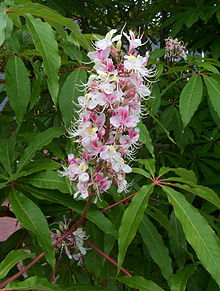Aesculus indica
| Aesculus indica | |
|---|---|

| |
| Aesculus indica, Indian horse chestnut at RBG Kew | |

| |
| Scientific classification | |
| Kingdom: | Plantae |
| Clade: | Tracheophytes |
| Clade: | Angiosperms |
| Clade: | Eudicots |
| Clade: | Rosids |
| Order: | Sapindales |
| Family: | Sapindaceae |
| Genus: | Aesculus |
| Species: | A. indica
|
| Binomial name | |
| Aesculus indica | |
| Synonyms[2] | |
|
Pavia indica Wall. ex Cambess. | |
Aesculus indica, commonly known as the Indian horse-chestnut[3] or Himalayan horse chestnut, is a species of deciduous broad-leaved tree in the family Sapindaceae.
Description
[edit]Aesculus indica is an attractive tree growing to 9–12 m (30–40 ft) with a spread of about 11–15 m (35–50 ft). It is hardy to −18 °C (0 °F), USDA zones 7–9.[4] It is in flower from June to July, and the seeds ripen in October. The flowers are hermaphroditic and with plentiful white blossoms during May and June pollinated by bees. Its large leaves 10–20 cm (3.9–7.9 in) long by 2–6 cm (0.79–2.36 in) wide are also ornamental and the mature tree forms a beautiful round canopy.[citation needed]
Distribution
[edit]It is common along the Himalayan Lowlands, between Kashmir and Western Nepal at elevations between 900 and 3,000 metres.[5] In the British Isles it is popular in many parks and estates where it was introduced in the mid-19th century. It is also found in many parts of the US.[4] The commercial collection of its seeds for flour production seems to have impacted on the natural distribution of this species.[citation needed]
Uses
[edit]Its leaves are used as cattle fodder in parts of Northern India. Its seeds are dried and ground into a bitter flour, called tattawakher. The bitterness is caused by saponins, which are rinsed out by thoroughly washing the flour during its preparation. The flour is often mixed with wheat flour to make chapatis[6] and also to make a halwa (Indian sweetmeat) and sometimes is served as a dalia, (a type of porridge or gruel) during fasting periods.
It is used in traditional Indian medicine for the treatment of various skin diseases and rheumatism, as well as functioning as an astringent, acrid, and narcotic. Additionally, it is employed to alleviate headaches.[6]
Its large leaves and flowers make it suitable for use as large-sized bonsai.[7]
In the UK, the cultivar 'Sydney Pearce'’ has gained the Royal Horticultural Society's Award of Garden Merit.[8]
References
[edit]- ^ Lakhey, P.; Pathak, J. (2020). "Aesculus indica". IUCN Red List of Threatened Species. 2020: e.T150283250A152201802. doi:10.2305/IUCN.UK.2020-3.RLTS.T150283250A152201802.en. Retrieved 5 August 2023.
- ^ "Aesculus indica (Wall. ex Cambess.) Hook. | Plants of the World Online | Kew Science". Plants of the World Online. Retrieved 2020-02-05.
- ^ BSBI List 2007 (xls). Botanical Society of Britain and Ireland. Archived from the original (xls) on 2015-06-26. Retrieved 2014-10-17.
- ^ a b Aesculus indica Fact Sheet ST-63 http://hort.ufl.edu/database/documents/pdf/tree_fact_sheets/aesinda.pdf
- ^ Indian Journal of Traditional Knowledge. Vol. 8(2), April 2009, pp. 285-286. Ethnobotany of Indian horse chestnut (Aesculus indica) in Mandi district, http://nopr.niscair.res.in/bitstream/123456789/3963/1/IJTK%208(2)%20285-286.pdf
- ^ a b Plants and people of Nepal, By N. P. Manandhar, Sanjay Manandhar, Pg. 76
- ^ D'Cruz, Mark. "Ma-Ke Bonsai Care Guide for Aesculus indica". Ma-Ke Bonsai. Archived from the original on 2011-07-14. Retrieved 2010-12-02.
- ^ "RHS Plantfinder - Aesculus indica 'Sydney Pearce'". Retrieved 4 January 2018.
External links
[edit]![]() Media related to Aesculus indica at Wikimedia Commons
Media related to Aesculus indica at Wikimedia Commons

